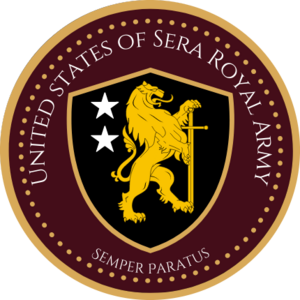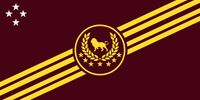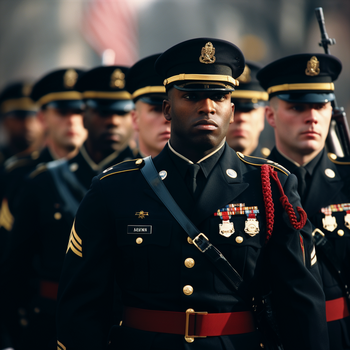Seran Royal Army
This article is incomplete because it is pending further input from participants, or it is a work-in-progress by one author. Please comment on this article's talk page to share your input, comments and questions. Note: To contribute to this article, you may need to seek help from the author(s) of this page. |
| Seran Royal Army | |
|---|---|
 Emblem of the Seran Royal Army | |
| Founded | June 7th, 1741 (283 years, 6 months) |
| Country | |
| Type | Army |
| Role | Prompt and sustained land combat Combined arms operations
Set and sustain the theater for the joint force Integrate national, multinational, and joint power on land |
| Size | 373,000 Regular Army personnel (2023) |
| Part of | Department of War Department of the Royal Army |
| Motto(s) | "Semper Paratus", "Always Ready" |
| Colors | Black, gold and red |
| Anniversaries | June 7th |
| Commanders | |
| Prime Minister / High Commander | Kaenan L. Bullock |
| Director of National Security | Deciumus Marius |
| Marshal of the Royal Army | Idris Oryx |
The United States of Sera Royal Army, also called the Royal Army, Royal Seran Army, US Army, and Union Army is the land service branch of the Seran military beneath the Department of War and Board of Defense Ministers. It is one of the 4 uniformed services operating under the Department of War in the United States of Sera, and one of the 7 total uniformed services in current operation. The Royal Army is headed by the Chief of the Army, a member of the Board of Defense Ministers and the highest-ranking army officer and the Secretary of the Royal Army. The Royal Army was officially established on June 7th, 1741 by the ratification of the Articles of Federation which laid out the organization, mission, and responsibilities for the Royal Seran Army.
The Royal Army is the oldest service branch of the Seran Armed Forces and takes seniority over the other branches barring the Valkiri Royal Guard. Established after the unification of the Seran tribes, the modern Seran Royal Army considers itself a direct continuation of the Union Army which was established with the Confederation of Seran Tribes in 1386. When the Quadrumvirate relinquished power to the new monarchy and Parliament, Parliament passed the "National Defense Act" on June 7th, 1741 which established many of the branches of the military still in operation to this day.
The Royal Army is part of the Department of the Royal Army which serves to lead, organize, and strategize with the other 3 departments operating under the Department of National Security and Department of War. The Royal Army is led by the highest-ranking army officer who also serves on the Board of Defense Ministers. It is the largest military branch by manpower, and is projected to remain so despite the growing recruitment numbers for the Royal Air Force and Royal Navy.
History
In the early half of Quadrumvirate rule in the present day capital of Kito'Bahari, the four chieftains in response to growing external threats to the Union of Seran Tribes, established the first Unified Army of Sera. Before the establishment of a national army, each state in the Seran Union provided their own troops and commanders for national defense. These commanders were prone to disagreements with each other, while soldiers from different tribes would routinely fight amongst themselves due to cultural differences. The Quadrumvirate sought to nullify the worst offenders by removing them from their position and sending them to prison to avoid possible coups against the Quadrumvirate. Soon thereafter, new commanders were appointed from within the tribes to take their place with a particular focus on unification and standardization over individualization and cultural differences.
Originally, the US Army handled both peacekeeping tasks domestically within the first tribal states while also juggling the demands of protecting the borders around the fledgling country from the neighboring violent tribes of ancient Adula. The Quadrumvirate, fearing nepotism, instituted a system amongst Sera's warriors that rewarded soldiers with prestige, wealth, and position for accomplishing certain tasks. These tasks included bringing the heads of enemy war-leaders, scalps, securing weaponry, repelling attacks, and spear-heading successful raids against enemy territories. Due to the ferocity at which Seran warriors pursued enemy heads and scalps, a reputation began to grow amongst their neighbors surrounding Seran brutality in war.
This reputation continued to grow as the Union of Sera entered into a war with the neighboring Nafuni Ze'teca Tribe known as the Seran-Ze'teca Extermination War. The conflict broke out when the Nafuni Ze'teca tribe crossed the Adula Mountains and entered into the Mbaku controlled tribe-lands. The Ze'teca immediately began to pillage and destroy any villages they came across and murdered any Seran inhabitants they captured. The newly formed national army was dispatched to combat the Ze'tecas. The Seran Army clashed several times over the next four years with the Ze'tecas; each time the officers in charge of the Seran soldiers ordered that no mercy be shown. Eventually, this harsh treatment of the Ze'teca would lead to the near total annihilation of the Nafuni Ze'teca nation as the Seran Army chased them across the mountains into their homeland. Although victorious, the Quadrumvirate quickly did away with the practice of rewarding soldiers for heads and scalps, partially due to the shame of nearly committing genocide.
| United States of Sera Armed Forces |
|---|
 |
| Executive departments |
| Staff |
| Military departments |
| Military service branches |
Structure and Mission
As established in the Articles of Federation, the purpose of the Royal Seran Army is described as:
- Maintaining the peace and security of the nation
- Providing for the defense of Unified Sera, its territories, people, and possessions,
- Combating any hostile power, organization, or nation that would do harm to the nation or to its people.
The Royal Seran Army's five core competencies are prompt and sustained land combat, combined arms operations (to include combined arms maneuver and wide–area security, armored and mechanized operations and airborne and air assault operations), special operations, to set and sustain the theater for the joint force, and to integrate national, multinational, and joint power on land.
Organization
Main Army
Special Operations Forces
Unified Sera Special Forces Command (USSFC)
| Name | Headquarters | Structure and purpose |
|---|---|---|
| 1st Special Forces Command (SFC) | Fort Zulu, Shaka | Manages seven special forces groups designed to deploy and execute nine doctrinal missions: unconventional warfare, foreign internal defense, direct action, counter-insurgency, special reconnaissance, counter-terrorism, information operations, counterproliferation of weapons of mass destruction, and security force assistance. The command also manages two psychological operations groups—tasked to work with foreign nations to induce or reinforce behavior favorable to Seran objectives |
| Special Operations Aviation Regiment (SOAR) | Fort Lakon, Aeminium | Commands, organizes, mans, trains, resources, and equips Army special operations aviation units to provide responsive, special operations aviation support to special operations forces consisting of five units. |
| Airborne Special Operations Group (ASOG) | Fort Xhosa, Istrus | In addition to a regimental headquarters, a special troops battalion, and a military intelligence battalion, the Airborne Special Operations Group has three maneuver battalions of elite airborne infantry specializing in large-scale, joint forcible entry operations and precision targeting raids. Additional capabilities include special reconnaissance, air assault, and direct action raids seizing key terrain such as airfields, destroying or securing strategic facilities, and capturing or killing enemies of the Nation. The Regiment also helps develop the equipment, technologies, training, and readiness that bridge the gap between special operations and traditional combat maneuver organizations. |
| The Menelik Kofi Center for Special Operations Training | Fort Hannibal, Carthage | Selects and trains special forces, civil affairs, and psychological operations soldiers consisting of two groups and other various training units and offices. |
| Placeholder | Fort Nzinga, Etoule | placeholder |
Equipment
The Royal Army made a goal to streamline the firearms and training of Seran troops by relying on a set number of weapons platforms with variants designed for specific purposes. These weapons are used in conjunction with vehicles and ordnance to round out the Seran weapon system used in the Seran army.
Vehicles
| Type | Active | Reserve |
|---|---|---|
| Main battle tanks | 2,800 | ≈16,500 |
| Infantry fighting vehicles | 5,160 | ≈19,500 |
| Armoured personnel carriers | 6,100 | ≈18,000+ |
| Towed artillery | 150 | ≈12,415 |
| Self-propelled artillery | 1,610 | ≈4,260 |
| Rocket Artillery | 1,352 | |
| Surface-to-air missile systems | 2,531 |
Weapons
| Model | Image | Caliber | Type | Origin | ||
|---|---|---|---|---|---|---|
| Pistols | ||||||
| P-12 |  |
.45 | Pistol | |||
| P-25 |  |
9 x 19mm | Pistol | |||
| Rifles | ||||||
| SR-14 |  |
6.8 x 51mm | Carbine | |||
| SR-13 |  |
6.8 x 51mm | Carbine | |||
| MR-11 |  |
.308 | Marksman/Sniper Rifle | |||
| LR-4 | File:XM250 NGSW.jpg | 6.8 x 51mm | Squad Machine Gun | |||
| CS-8 | .12ga 00 / Rifled Slugs | Combat Shotgun | ||||










